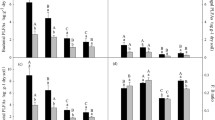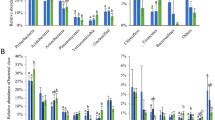Abstract
Soil microbial communities are closely associated with aboveground plant communities, with multiple potential drivers of this relationship. Plants can affect available soil carbon, temperature, and water content, which each have the potential to affect microbial community composition and function. These same variables change seasonally, and thus plant control on microbial community composition may be modulated or overshadowed by annual climatic patterns. We examined microbial community composition, C cycling processes, and environmental data in California annual grassland soils from beneath oak canopies and in open grassland areas to distinguish factors controlling microbial community composition and function seasonally and in association with the two plant overstory communities. Every 3 months for up to 2 years, we monitored microbial community composition using phospholipid fatty acid (PLFA) analysis, microbial biomass, respiration rates, microbial enzyme activities, and the activity of microbial groups using isotope labeling of PLFA biomarkers (13C-PLFA). Distinct microbial communities were associated with oak canopy soils and open grassland soils and microbial communities displayed seasonal patterns from year to year. The effects of plant species and seasonal climate on microbial community composition were similar in magnitude. In this Mediterranean ecosystem, plant control of microbial community composition was primarily due to effects on soil water content, whereas the changes in microbial community composition seasonally appeared to be due, in large part, to soil temperature. Available soil carbon was not a significant control on microbial community composition. Microbial community composition (PLFA) and 13C-PLFA ordination values were strongly related to intra-annual variability in soil enzyme activities and soil respiration, but microbial biomass was not. In this Mediterranean climate, soil microclimate appeared to be the master variable controlling microbial community composition and function.






Similar content being viewed by others
References
Abraham, WR, Hesse, C, Pelz, O (1998) Ratios of carbon isotopes in microbial lipids as an indicator of substrate usage. Appl Environ Microbiol 64: 4202–4209
Allen, MF, Morris, SJ, Edwards, F, Allen, EB (1995) Microbe-plant interactions in Mediterranean-type habitats: shifts in fungal symbiotic and saprophytic functioning in response to global change. In: Moreno, JM, Oechel, WC (Eds.) Ecological Studies: Global Change and Mediterranean-type Ecosystems, Springer-Verlag, New York, pp 287–305
Arao, T (1999) In situ detection of changes in soil bacterial and fungal activities by measuring 13C incorporation into soil phospholipid fatty acids from 13C acetate. Soil Biol Biochem 31: 1015–1020
Balser, TC, Firestone, MK (2004) Linking microbial community composition and soil processes in California annual grassland and mixed-conifer forest. Biogeochemistry 73: 395–415
Bardgett, RD, Lovell, RD, Hobbs, PJ, Jarvis, SC (1999) Seasonal changes in soil microbial communities along a fertility gradient of temperate grasslands. Soil Biol Biochem 31: 1021–1030
Bever, JD (1994) Feedback between plants and their soil communities in an old field community. Ecology 75: 1965–1977
Bohlen, PJ, Groffman, PM, Driscoll, CT, Fahey, TJ, Siccama, TG (2001) Plant-soil-microbial interactions in a northern hardwood forest. Ecology 4: 965–978
Bossio, DA, Scow, KM, Gunapala, N, Graham, KJ (1998) Determinants of soil microbial communities: effects of agricultural management, season, and soil type on phospholipid fatty acid profiles. Microb Ecol 36: 1–12
Brodie, E, Edwards, S, Clipson, N (2002) Bacterial community dynamics across a floristic gradient in a temperate upland grassland ecosystem. Microb Ecol 44: 260–270
Broughton, LC, Gross, KL (2000) Patterns of diversity in plant and soil microbial communities along a productivity gradient in a Michigan old-field. Oecologia 125: 420–427
Downie, DE, Taskey, RD (1997) Soil characteristics of blue oak and coast live oak ecosystems. USDA Forest Service Gen. Tech. Rep. PSW-GTR-160: pp 65–73
Fog, K (1988) The effect of added nitrogen on the rate of decomposition of organic matter. Biol Rev Camb Philos Soc 63: 433–462
Freeman, C, Ostle, N, Kang, H (2001) An “enzymatic latch” on a global carbon store. Nature 409: 149
Frey, SD, Elliott, ET, Paustian, K (1999) Bacterial and fungal abundance and biomass in conventional and no-tillage agroecosystems along two climatic gradients. Soil Biol Biochem 31: 573–585
Harrison, AF (1971) The inhibitory effect of oak leaf litter tannins on the growth of fungi, in relation to litter decomposition. Soil Biol Biochem 3: 167–172
Ishikawa, CM, Bledsoe, CS (2000) Seasonal and diurnal patterns of soil water potential in the rhizosphere of blue oaks: evidence for hydraulic lift. Oecologia 125: 459–465
Jackson, LE, Strauss, RB, Firestone, MK, Bartolome, JW (1990) Influence of tree canopies on grassland productivity and nitrogen dynamics in deciduous oak savanna. Agric Ecosyst Environ 32: 89–105
Legendre, P, Gallaghher, ED (2001) Ecologically meaningful transformations for ordination of species data. Oecologia 129: 271–280
Myers, RT, Zak, DR, White, DC, Peacock, A (2001) Landscape-level patterns of microbial community composition and substrate in upland forest ecosystems. Soil Sci Soc Am J 65: 359–367
Page, AL, Miller, RH, Keeney, DR (1982) Methods of Soil Analysis, Part 2. ASA, Madison, WI
Rogers, BF, Tate, RL (2001) Temporal analysis of the soil microbial community along a toposequence in Pineland soils. Soil Biol Biochem 33: 1389–1401
Roslev, P, Iversen, N, Henriksen, K (1998) Direct fingerprinting of metabolically active bacteria in environmental samples by substrate specific radiolabelling and lipid analysis. J Microbiol Methods 31: 99–111
Scalbert, A (1991) Antimicrobial properties of tannins. Phytochemistry 30: 3875–3884
Schadt, CW, Martin, AP, Lipson, DA, Schmidt, SK (2003) Seasonal dynamics of previously unknown fungal lineages in tundra soils. Science 301: 1359–1361
Sinsabaugh, RL, Antibus, RK, Linkins, AE, McClaugherty, CA, Rayburn, L, Repert, D, Weiland, T (1993) Wood decomposition nitrogen and phosphorus dynamics in relation to extracellular enzyme activity. Ecology 74: 1586–1593
Smit, E, Leeflang, P, Gommans, S, Van Den Broek, J, Van Mil, S, Wernars, K (2001) Diversity and seasonal fluctuations of the dominant members of the bacterial soil community in a wheat field as determined by cultivation and molecular methods. Appl Environ Microbiol 67: 2284–2291
Stark, JM, Firestone, MK (1995) Mechanisms for soil moisture effects on activity of nitrifying bacteria. Appl Environ Microbiol 61: 218–221
Steenwerth, KL, Jackson, LE, Calderon, FJ, Stromberg, MR, Scow, KM (2003) Soil microbial community composition and land use history in cultivated and grassland ecosystems of coastal California. Soil Biol Biochem 35: 489–500
Vaughn, CE, Center, DM, Jones, MB (1986) Seasonal fluctuations in nutrient availability in some northern California annual range soils. Soil Sci 141: 43–51
Waldrop, MP, Firestone, MK (2004) Microbial community utilization of recalcitrant and simple carbon compounds: impact of oak–woodland plant communities. Oecologia 2: 275–284
Waldrop, MP, McColl, JG, Powers, RF (2003) Effects of forest postharvest management practices on enzyme activities in decomposing litter. Soil Sci Soc Am J 4: 1250–1256
Wardle, DA (1998) Controls of temporal variability of the soil microbial biomass: a global-scale synthesis. Soil Biol Biochem 30: 1627–1637
Wardle, DA, Yeates, GW, Williamson, W, Bonner, KI (2003) The response of a three trophic level soil food web to the identity and diversity of plant species and functional groups. Oikos 102: 45–56
White, DC, Ringelberg, DB (1998) Signature lipid biomarker analysis. In: Burlage, RS, Atlas, R, Stahl, D, Geesey, G, Sayler, G (Eds.) Techniques in Microbial Ecology, Oxford University Press, New York, pp 255–272
Zak, DR, Tilman, D, Parmenter, RR, Rice, CW, Fisher, FM, Vose, J, Milchunas, D, Martin, CW (1994) Plant production and soil microorganisms in late-successional ecosystems—a continental-scale study. Ecology 75: 2333–2347
Acknowledgments
We thank the Hopland Research and Extension Center for the gracious support of this project, Charles Vaughn for his help with phosphorus determinations, Tamas Torok at Lawrence Berkeley National Laboratories for his help with PLFA determination, and David Harris and the University of California Davis isotope facility for the use of their instrumentation. This work was made possible by financial support from the Kearney Foundation for Soil Science Research and California AES project 6117-H.
Author information
Authors and Affiliations
Corresponding author
Rights and permissions
About this article
Cite this article
Waldrop, M.P., Firestone, M.K. Seasonal Dynamics of Microbial Community Composition and Function in Oak Canopy and Open Grassland Soils. Microb Ecol 52, 470–479 (2006). https://doi.org/10.1007/s00248-006-9100-6
Received:
Revised:
Accepted:
Published:
Issue Date:
DOI: https://doi.org/10.1007/s00248-006-9100-6




